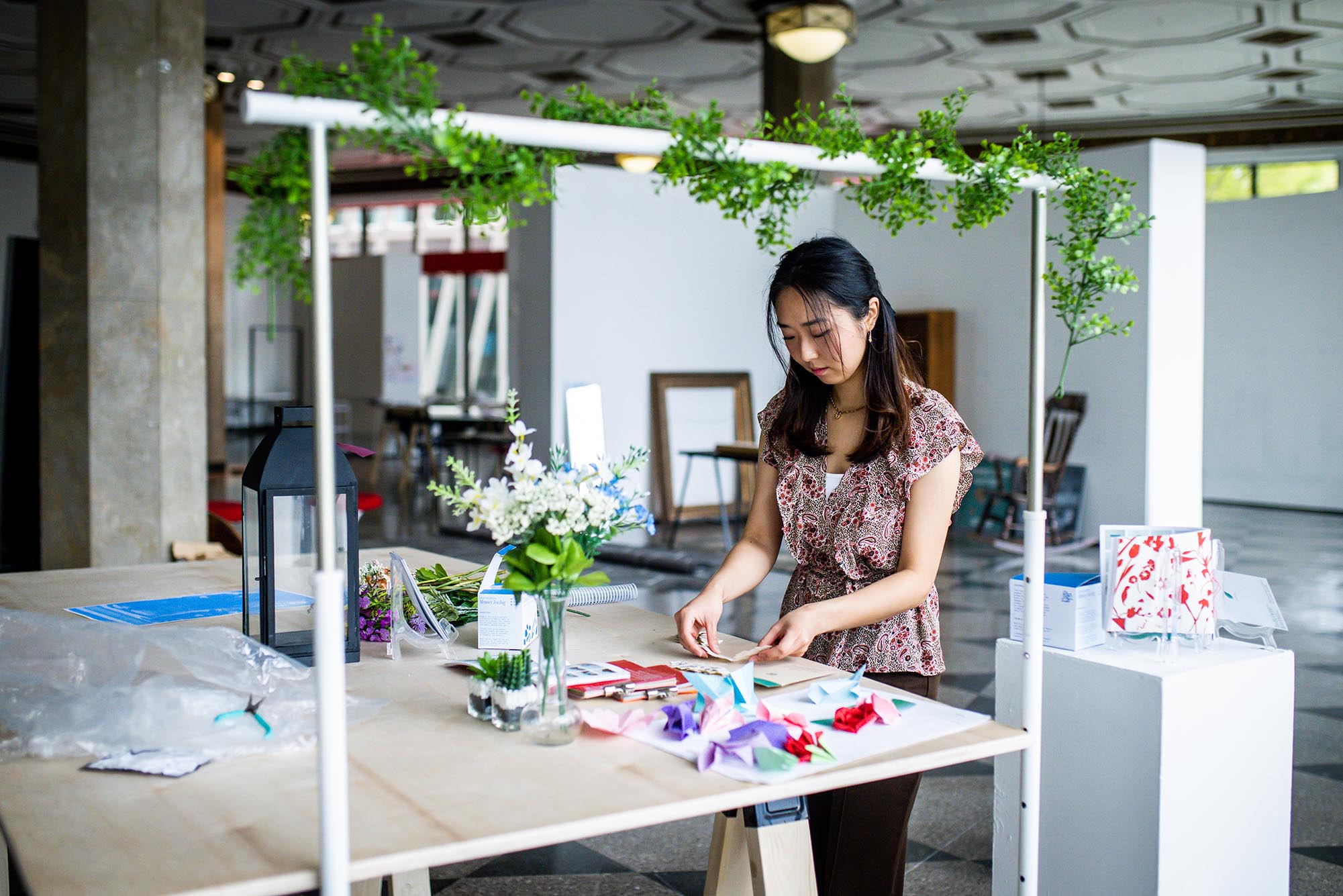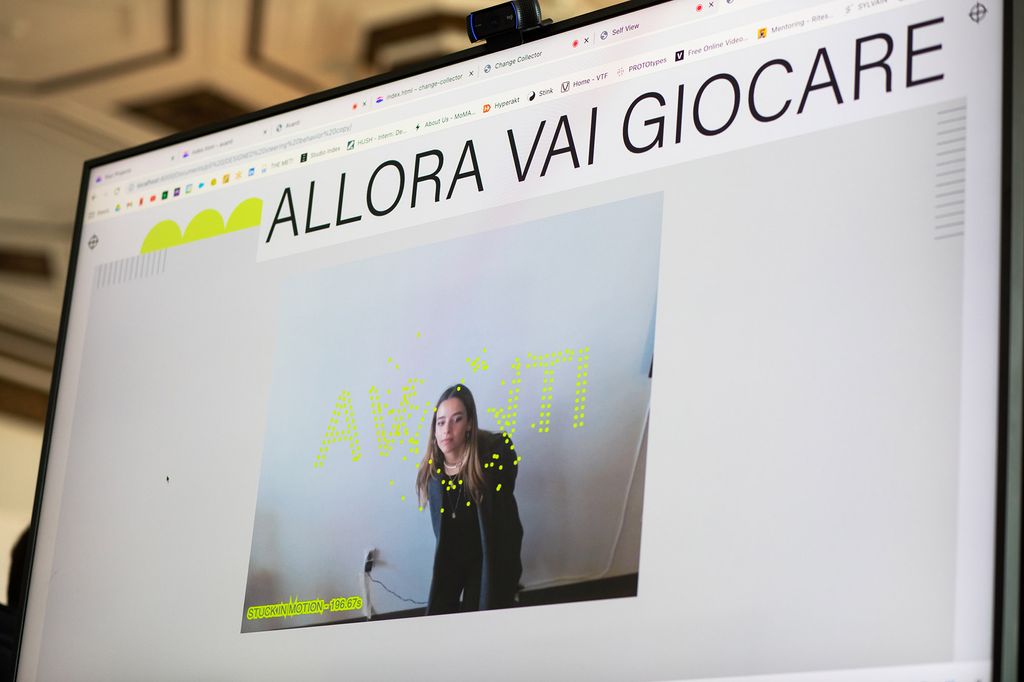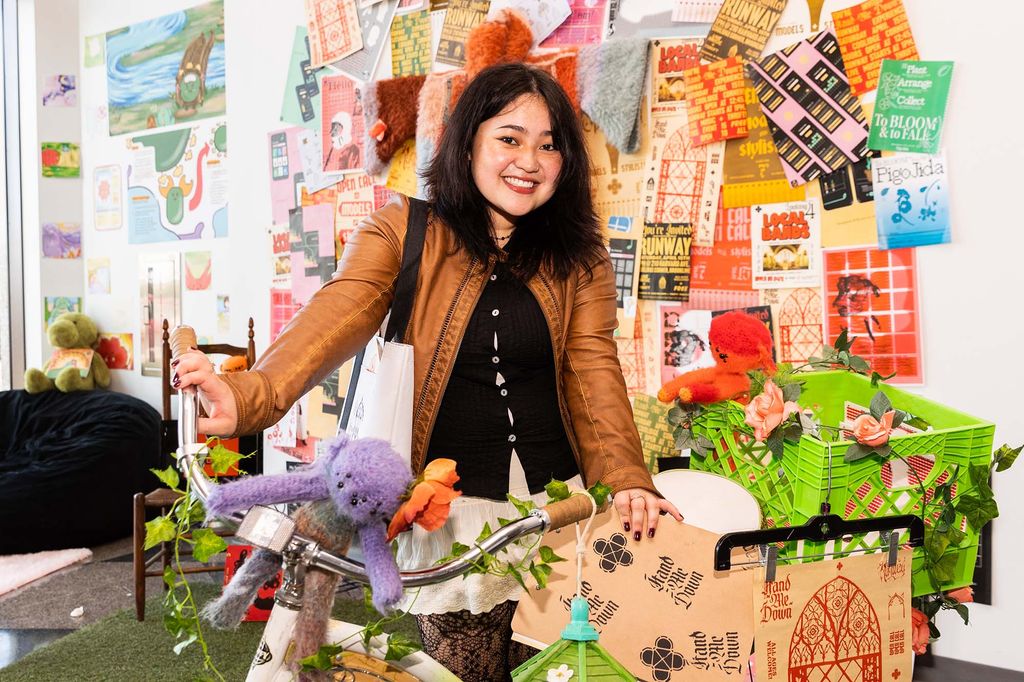2023 BFA Graphic Design Thesis Show on View at 808 Gallery

Mina Chung (CFA’23) sets up her thesis exhibit ahead of the 2023 BFA Graphic Design Thesis Exhibition at the 808 Gallery. Chung’s thesis is concerned with flowers and their association with rituals of gift-giving, grief, and ephemerality. Photo by Jackie Ricciardi
2023 BFA Graphic Design Thesis Show on View at 808 Gallery
More than 150 works by 41 graduating seniors can be seen through May 19
This article was first published in BU Today on May 11, 2023. By Sophie Yarin
Excerpt
It’s thesis season for the graduating seniors in the College of Fine Arts School of Visual Arts, and this year the BFA graphic design program is faced with a unique challenge: its largest graduating class ever. The order of the day for the 41 graduating seniors has been organizing the more than 160 works into a cohesive show. As it turns out, they have proven themselves more than up to the task as visitors to the 2023 Graphic Design Senior Thesis Exhibition, now on view at the 808 Gallery, will discover.
“They have a pretty collaborative and familial dynamic, and this dynamic is present in how they have decided to curate their show,” Nicholas Rock, an assistant professor of art and graphic design at the College of Fine Arts, says of his thesis students. “They’re celebrating their connections, as well as their individuality and personal perspectives, in their work.”
The theme of this year’s BFA Thesis Exhibitions (the BFA painting, sculpture, and printmaking show running concurrently across the street at the Faye G., Jo, and James Stone Gallery at 855 Comm Ave.) is “EDIFICE.”
The task of creating a curatorial theme that embraces the more than 200 works included in both shows fell to Mina Chung (CFA’23), Hannah Hong (CFA’23), and Jacqueline Mang (CFA’23), all graphic design majors and members of the thesis exhibition branding team. “EDIFICE plays on the idea of the home and community we have at CFA, and the foundation that has been laid for our education, careers, passions, and futures,” Chung says.
The concept behind EDIFICE—that the collective artistic practices of each student form a creative scaffold like that of a physical institution—influenced the graphic design exhibition, which Chung says also has an independent brand imprint, “Lived In,” which imagines the 808 Gallery as a shared domestic space and each thesis project as a room in a house.
The “room” in the 808 Gallery occupied by Chung’s thesis—in reality, a table draped in flowers—consists of plantable seed paper postcards and origami flower kits. The blooms, to Chung, symbolize a ritual she adopted while grieving a loved one.
“For me, both flowers and rituals have brought comfort and a reminder of the simplicity of life [and] I wanted to examine the idea of collecting, gifting, and eventually letting go,” she explains. “The interactivity of the design was crucial to engage the audience in the meaningful act of gift-giving through custom flower arrangements.”

Andreina De La Blanca (CFA’23) demonstrates one of the “mini experiences,” or interactive games, she created for her graphic design thesis. De La Blanca practices creative coding, or computer programming that prioritizes artistic expression. Photo by Jake Belcher

August Ramos (CFA’23) shows off some of the ephemera seen in her senior thesis runway show, “HAND-ME-DOWN,” which she held in April. Ramos completed the project in partnership with United Parish of Brookline, BU’s Fabrio magazine, and more than 70 volunteer models, stylists, and event staff. Photo by Jake Belcher

Perry Sosi (CFA’23) sets up merchandise related to his thesis at the 808 Gallery on May 9. Sosi’s thesis, “Pferda People,” draws on a 292-person survey of the BU community in which he asked participants about their global and local concerns. Photo by Jake Belcher
A few yards away, Andreina De La Blanca’s “room” is devoted to the practice of creative coding, a “relatively new” form of programming that prioritizes artistic expression over pure functionality.
De La Blanca’s thesis exhibit consists of a monitor display featuring two interactive games of her own fabrication. De La Blanca (CFA’23), who learned the practice only recently, designed these “mini experiences” to reflect the process of going outside one’s comfort zone and confronting uncertainty. Viewers are instructed to step in front of a webcam and interact with the screen, then watch themselves move about on the monitor and respond to prompts designed to confuse and challenge.
“In its nature, creative coding can be all about happy accidents and newness,” she says.
De La Blanca says that her fascination with the risk and reward of the unknown stems from her experience of immigrating multiple times—first from Venezuela to Madrid, then to Rome, Miami, and finally Boston.
“By the end [of each mini experience], I aim to get my point across on change being an enjoyable aspect of life,” she says, “even if at first it’s something intimidating or unknown.”
We would consider ourselves a media-agnostic graphic design program in that we see tools as tools and encourage students to move in and around them and to constantly leverage their curiosity. I think seeing the students fully realize their own sense of authorship and control of their craft is amazing.
Undergraduate students at SVA start their careers in a foundations curriculum that emphasizes the basics—primarily drawing, but augmented by painting, sculpture, and art history—before majors are declared in the second year. From there, graphic design students are encouraged to experiment with tools and techniques, according to Rock, which accounts for the immense variety in the annual thesis exhibitions.
“We would consider ourselves a media-agnostic graphic design program in that we see tools as tools and encourage students to move in and around them and to constantly leverage their curiosity,” Rock says. “I think seeing the students fully realize their own sense of authorship and control of their craft is amazing.”